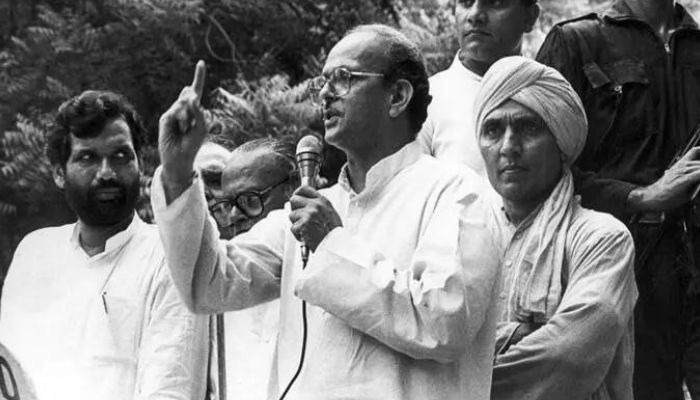The day was 7th August 1990. India’s then Prime Minister VP Singh had accepted the infamous Madal Commission report, which recommended 27% reservation for Other Backward Classes (OBCs).
The report [pdf], which ushered into a new era of affirmative action and appeasement politics, was originally prepared by ex-Chief Minister of Bihar Bindeshwari Prasad Mandal in 1980 on the directive of the Moraji Desai-led-Janata Dal government.
The subsequent governments of Indira Gandhi and her son Rajiv Gandhi had put the report in hibernation until it was brought back to life in 1990 by VP Singh. His decision to increase the total reservation to 49% (SCs, STs and OBCs) changed the course of Indian politics forever.
The first wave of protests began in the National Capital of Delhi. There were candle-lit processions, silent demonstrations near the India Gate, arbitrary suspension of classes at the Delhi University and even hijacking of DTC buses.
Media reports from that time indicate that the protests, mostly spearheaded by student groups, were scattered, sporadic and loose-knit. Fuelled by widespread anger and spontaneity, they conducted rallies, bandhs and hartals to convey their resentment to the government.
A major turning point in the anti-Mandal agitation came on 19th September 1990 when 19-year-old Rajeev Goswami poured oil and set himself on fire in protest. Goswami was a student of Deshbandhu College.
The disturbing incident was witnessed by hundreds of protestors and media persons. Although he managed to survive with 50% burns, Goswami’s act of self-immolation persuaded other general-category students to follow suit.
One such case was that of Monica Chadha, who was 19 at that time. She poured gasoline on herself and set herself ablaze. Even on her deathbed, Chadha was unperturbed about her decision.
“Today, I want to teach a lesson to V. P. Singh. I am proud of what I have done,” she was quoted as saying by Los Angeles Times.

In Haryana, a student named Sushil Kumar died by consuming insecticide and held V.P. Singh responsible for his death.
One Narinder Kaur, who hailed from Punjab, also hung herself and donated her eyes to the then Prime Minister in a suicide note so that he could see the misery of the student community. Another student named Surinder Singh Chauhan died of self-immolation.
Reportedly, a whopping 159 people attempted suicide to protest against awarding OBC reservations. 63 of them succumbed to their injuries.
While recounting the matter, Dalit Singh wrote in The Telegraph, “Till Rajeev lit the match, the agitation was being viewed as a campaign aimed at derailing social reforms and not many were willing to speak up in defence of the opponents of reservation — a political holy cow. But Rajeev’s reckless act changed the tone and texture of the agitation, which overnight came to be viewed as a movement spearheaded by selfless youths.”
The aftermath of VP Singh’s political decision
The BJP withdrew its support from the VP Singh government over the issue, leading to its eventual collapse. A young lawyer named Indra Sawhney moved the Supreme Court of India challenging the decision of the government. The apex court, however, upheld the constitutional validity of 27% OBC reservation in 1992.
The anti-Mandal protests eventually died down and there was reportedly no opposition when the Narasimha Rao-led-Congress government announced the implementation of the Mandal Commission report in 1993. It took more than 13 years for OBC reservations in educational institutions to finally see the light of the day.
The agitation divided the society in an unprecedented manner. In 2012, columnist Anu Kumar wrote in The Hindu newspaper, “Suddenly things that hadn’t mattered before, like people’s surnames, took on a greater importance, and appeared in a totally new light…”
Ex-NDTV journalist’ Sanjay Ahirwal, who participated in the anti-Mandal protests but later became pro-reservation conceded in a 2021 article for The Quint, “VP Singh’s attempts to politicise the issue only resulted in deepening a social divide which was till then not seen in the more progressive Delhi University.”
Rajeev Goswami, the face of the anti-Modal protests, passed away in 2004 in obscurity. His brother Mahendra told The Telegraph, “Rajeev used to lament that the self-immolation attempt did not have any impact.”
A 12-year-old boy named Atul Aggarwal, who had set himself ablaze during the 1990s protest, still has no explanation as to why he took such a drastic decision.

He told The Indian Express, “Everywhere, people were only talking about the Mandal report. Rallies were being held, roads were blocked, youngsters were killing themselves. As a child, I felt I should be part of this movement though I did not understand what it stood for.”
Aggarwal went on to study at IIT Kharagpur and IIM Calcutta as a general-category student.
On being asked about reservations, he stated, “It’s bullsh*t. Give free education and financial assistance to disadvantaged castes. Why punish someone who was born into an upper-caste family?”
Featured Image of ex-Prime Minister VP Singh via Jansatta
The article was first published in Opindia on 20th July 2024.




